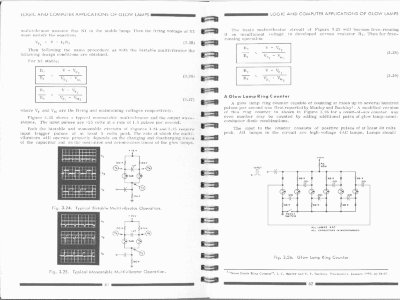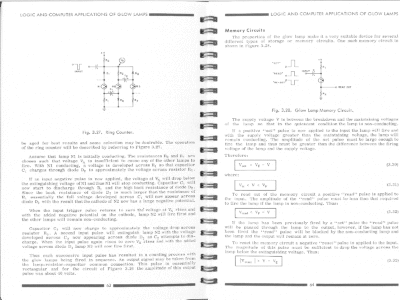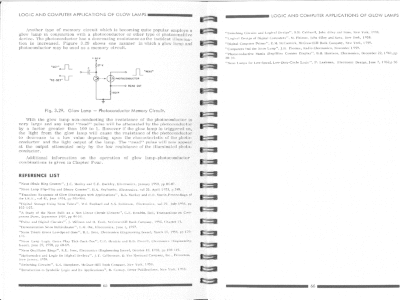Forrest M. Mims
THE NEON GLOW LAMP
In this day of solid-state technology, the humble neon glow lamp still has much to offer to the experimenter. Besides its luminescence, the glow bulb displays negative resistance behavior. Because of this, it is often found in voltage regulator and relaxation oscillator circuits. Best of all, glow lamps are inexpensive. You can purchase them from advertisers in the Electronics Marketplace for as little as a nickel each in quantities of several dozen.
Before we look at some interesting glow lamp circuits, let's review some of the basic operating principles of this versatile component. Knowledge of its operating characteristics will enable you to design your own circuits.
An outline view of a typical glow lamp is shown in Fig. 1. Few electronic components are as structurally simple - a glow lamp consists merely of a gas-filled bulb and a pair of electrodes to which wire leads have been attached. Normally, the resistance of the gas between the two electrodes is so high that the lamp can be considered an open circuit. But when the voltage across the lamp is raised to the critical initial breakdown voltage, the gas ionizes and becomes highly conductive. The ionized gas glows with a characteristic color. Neon, the most common filler gas, glows orange. Argon, which is sometimes used, has a blue glow.
Figure 2 shows the I-V characteristics of a typical neón bulb. Until the breakdown voltage VB is reached, current through the lamp is very small. (This voltage will vary between 55 and 150 volts for commercially available bulbs.) When the bulb fires, it enters the normal glow region of its I-V curve. In this region, the soft, luminous glow is confined to the negative electrode, and the glow area increases directly with lamp current. The voltage-regulating properties of the neon lamp are self-evident in Fig. 2. A nearly constant voltage drop VO exists across the lamp even though the current varies over a wide range.
When current is so high that the entire surface of the electrode ís covered by the glow, the voltage across the lamp rises. The neon lamp has then entered the abnormal glow region. If lamp current further increases, the lamp is operating in the arc region. Here, the voltage across the lamp drops and the orange-colored discharge becomes a bright point of bluish-white light centered on the cathode (negative) electrode. Prolonged operation ih the abnormal glow region, and even a brief incursion into the arc region will destroy the lamp.
Although neon lamps operate at fairly high voltages, they consume small amounts of power, and most commercial devices are rated at a continuous current of 0.1 to 10 mA.
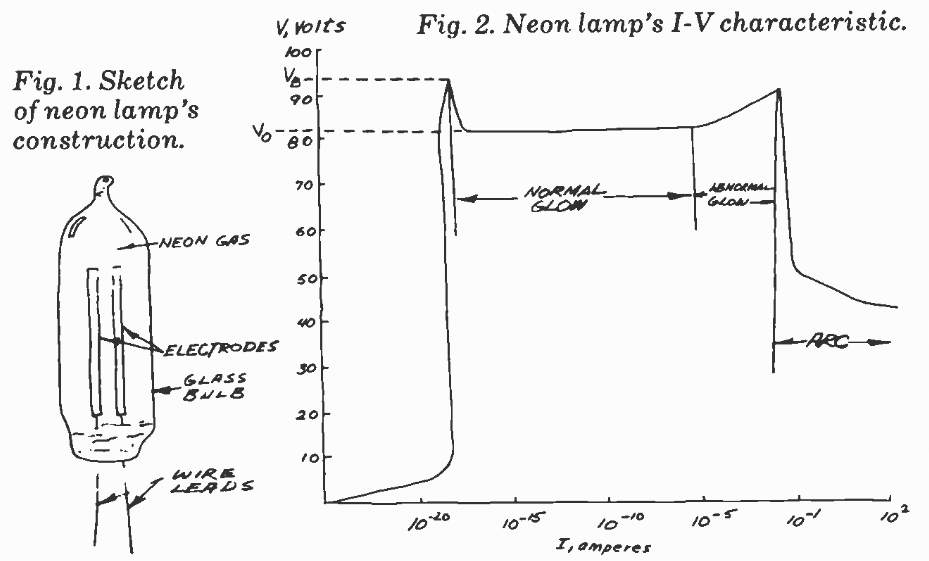
Some Precautions. Neon glow lamps are simple to use, but you should be aware of a few special restrictions. First, these lamps are subiect to what is called the dark effect. That is, ionization of the gas is much more easily accomplished in the presence of ambient light. In total darkness, the glow lamp operates erratically, and its breakdown voltage increases significantly. To overcome this problem, many neon lamps contain a minute amount of radioactive gas, which stimulates ionization.
A second operating restriction is the necessity to avoid excessive operating voltages. Too much voltage will cause the lamp to operate in the abnormal glow or arc region. The third consideration is current limiting. It is necessary to place a resistor in series with a continuously operated glow lamp. This ballast resistor limits the current through the lamp to a safe value. If we assume that an ionized glow lamp has practically no resistance but a voltage drop of 80 volts, Ohm's and Kirchoff's Laws dictate that a 100,000-ohm ballast resistor will allow a safe 200 μA to flow through a glow lamp connected to a 100-volt dc source.
Glow Lamp Circuits. Now that we've covered some of the basics of glow lamp operation, let's examine several practical circuits. You can use the miniature dc-dc converter described in last month's column or a pair of 67 1/2-volt batteries connected in series as a power supply.
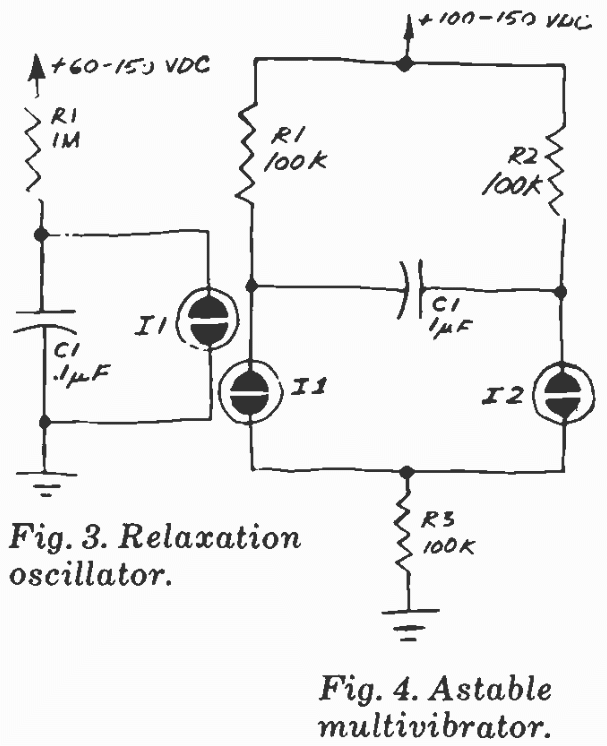
The simplest circuit is the glow-lamp relaxation oscillator shown in Fig. 3. In operation, Cl charges through R1 until the breakdown voltage of the neon lamp is reached. At that point, Cl discharges through the lamp and produces an orange flash. When the voltage across Cl drops below the voltage necessary to keep the lamp conducting, the lamp goes dark. Then Cl begins to charge and the cycle repeats.
To see the glow-lamp flash you will have to use at least a 1-megohm resistor. Otherwise the flash rate will be faster than the 18 pulses per second discernible by the human eye and the lamp will appear continuously on. Also, use 200-volt capacitors in this and the following circuits because of the high voltages present.
You can connect an oscilloscope across C1 to verify that the circuit is oscillating if you choose to operate it at audio frequencies. Alternatively, you can connect an 8-ohm speaker between the glow lamp and ground or place the circuit near a radio to actually hear the oscillation frequency or its harmonics.
If you're familiar with neon-lamp relaxation oscillators, you probably know that several circuits like the one shown in Fig. 3 can be cascaded to produce a pseudo-random flashing effect. These circuits are often seen flashing away in electronics labs and are called "do-noth ing boxes" or "idiot lights."
An astable multivibrator made from two glow lamps is shown in Fig. 4. If we assume I1 has a lower turn-on voltage than I2, I1 will turn on first after power has been applied. This permits Cl to charge through R2 and I1. When the voltage across Cl exceeds the turn-on voltage of I2, I2 turns on and I1 turns off. Now Cl charges through R1 and I2 until its charge fires I1. Lamp I2 then turns off, Cl begins charging through R2, and the cycle repeats. The circuits described here incorporate a relaxation oscillator, and you can easily vary the repetition rates of the oscillators by altering the values for the resistor and capacitor which, together with the lamp, form the oscillator (R1 and Cl in Fig. 3, etc.). Higher values of resistance or capacitance will slow the repetition rate. But try to keep R1 above 100,000 ohms, and Cl below 1μF.
If you do experiment with any of these circuits, be sure to observe standard safety precautions. Even a 67 1/2-volt battery can deliver a sharp shock, and if the shock itself doesn't affect you, the resulting reflex action may dash your wrist or elbow into your work bench or chair. For best results and optimum safety, stick to batteries or miniature high-voltage power supplies like the one described in last month's column. If you must use line power, never operate a glow-lamp circuit from the ac line without using a 1:1 isolation transformer.
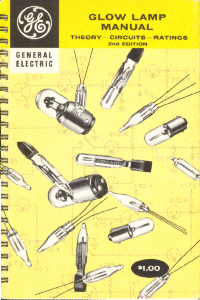 The following pages are scanned from the GE Glow Lamp Manual, 2nd Edition,
dated 1965.
The following pages are scanned from the GE Glow Lamp Manual, 2nd Edition,
dated 1965.
|
